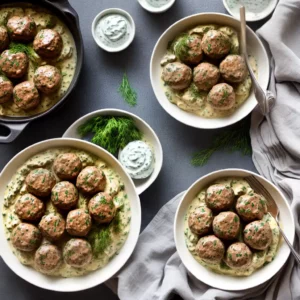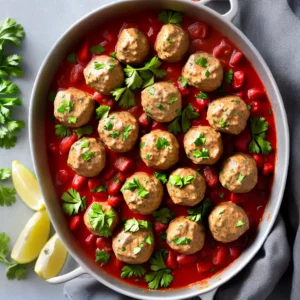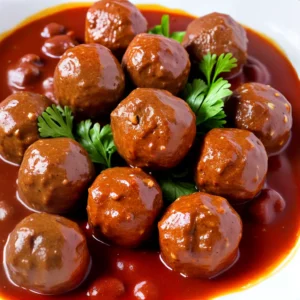Hello, I’m here to guide you on how to defrost chicken safely. When it comes to defrosting chicken, it’s crucial to follow proper food safety guidelines to minimize the risk of bacteria growth. By using the correct methods, you can ensure that your chicken remains delicious and safe to eat.
There are several techniques you can utilize to defrost chicken, depending on your needs and time constraints. In this article, I will explain the best methods for defrosting chicken in the fridge, in water, and in the microwave. Additionally, I will address important considerations such as cooking frozen chicken, storage times for thawed chicken, and whether it’s safe to refreeze chicken.
Key Takeaways:
- Defrosting chicken safely is essential to avoid bacterial growth and foodborne illness.
- The best method for defrosting chicken is in the fridge, as it maintains a cool and consistent temperature.
- If you need to defrost chicken quickly, you can use the water method by submerging it in a leak-proof bag in cold water.
- Thawing chicken in the microwave is a quick option, but caution must be taken to prevent uneven thawing.
- Cooking chicken from frozen is possible, but it requires adjustments to cooking times and ensuring it reaches a safe internal temperature.
The Best Way to Defrost Chicken in the Fridge
When it comes to defrosting chicken, the safest method is to do it in the fridge. This slow and controlled process ensures that the chicken stays at a cool temperature throughout, minimizing the risk of bacteria growth. To defrost chicken in the fridge, simply place the chicken in a leak-proof plastic bag or container and leave it in the refrigerator overnight. This method allows the chicken to thaw gradually, preserving its texture and flavor.
Defrosting chicken in the fridge may be the slowest method, but it is the most reliable and convenient. It requires minimal effort and allows you to plan your meals in advance. Plus, the gradual thawing in the fridge ensures that the chicken remains at a safe temperature, reducing the risk of foodborne illnesses. Remember to place the chicken on the lowest shelf of the fridge to prevent any cross-contamination with other foods.
If you’re short on time, defrosting chicken in the fridge may not be the ideal option. In that case, you can consider alternative methods such as defrosting in water or using the microwave. However, it’s important to note that these methods may not achieve the same level of safety and quality as defrosting in the fridge.
Tips for Defrosting Chicken in the Fridge:
- Place the chicken in a leak-proof bag or container to prevent any juices from leaking onto other foods in the fridge.
- Store the chicken on the lowest shelf of the fridge to avoid cross-contamination with other foods.
- Plan ahead and defrost the chicken in the fridge overnight or for at least 24 hours for larger cuts.
Table: Comparing Defrosting Methods
| Defrosting Method | Safety Level | Thawing Time | Quality of Chicken |
|---|---|---|---|
| Defrosting in the Fridge | Safest | Slowest | Best quality, texture, and flavor |
| Defrosting in Water | Less safe | Quicker than the fridge | Some loss of quality and texture |
| Defrosting in the Microwave | Least safe | Fastest | Potential loss of quality and texture |
“Defrosting chicken in the fridge is the best and safest method. It allows for a slow thawing process, ensuring the chicken remains at a cool temperature throughout. This method is ideal for preserving the quality, texture, and flavor of the chicken.”
Defrosting Chicken in Water
If you find yourself in need of thawing chicken quickly, the water method is a viable option. To defrost chicken in water, start by placing the chicken in a leak-proof plastic bag to prevent any water absorption. Fill a bowl with cold tap water and submerge the bagged chicken in it. It’s important to change the water every 30 minutes to keep it cold and maintain a safe temperature.
This quick method of defrosting chicken in water allows for faster thawing compared to the refrigerator method. However, it’s crucial to ensure the water remains cold throughout the process to prevent bacterial growth. Using cold water slows down bacteria multiplication, ensuring the chicken remains safe to consume. It’s important to note that using warm or hot water is not recommended as it can bring the chicken into the temperature danger zone where bacteria can proliferate rapidly.
Once the chicken is fully thawed, it’s essential to handle it with care. Ensure that the chicken is thoroughly cooked to a safe internal temperature of 165°F (74°C) to eliminate any potential bacteria. You can use a food thermometer to accurately measure the temperature. Remember to discard any unused defrosting water and clean the sink or bowl with hot, soapy water to avoid cross-contamination.
Tips for Defrosting Chicken in Water:
- Use a leak-proof plastic bag to prevent water absorption and potential contamination.
- Ensure the chicken is fully submerged in cold water throughout the thawing process.
- Change the water every 30 minutes to maintain a safe temperature.
- Thoroughly cook the chicken to an internal temperature of 165°F (74°C) to eliminate bacteria.
- Discard the defrosting water and clean the sink or bowl with hot, soapy water afterward.
“Defrosting chicken in water is a quick and effective method when time is of the essence. Just remember to follow food safety guidelines and cook the chicken thoroughly to prevent any risk of foodborne illness.” – Food Safety Expert
Defrosting Chicken in a Microwave
When it comes to defrosting chicken quickly, the microwave can be a convenient option. However, it’s important to exercise caution to ensure the chicken is thawed evenly and safe to eat. Here are some key points to keep in mind:
- Use the defrost setting: Most microwaves come with a defrost setting that is specifically designed for thawing frozen foods. This setting uses a lower power level to slowly and evenly thaw the chicken without cooking it.
- Defrost only what you need: It’s best to defrost only the amount of chicken you need for immediate cooking. This prevents any leftover chicken from sitting at room temperature for an extended period, which could increase the risk of bacteria growth.
- Cook immediately after thawing: Once the chicken is fully thawed in the microwave, it’s important to cook it immediately. The microwave can partially cook the chicken during the defrosting process, so cooking it right away ensures it reaches a safe internal temperature.
“Using the microwave to defrost chicken is a quick method, but it’s crucial to follow the proper steps to prevent any food safety issues. Always use the defrost setting, defrost only what you need, and cook the chicken immediately after thawing.”
It’s worth noting that while the microwave is a quick method for defrosting chicken, it may not be the best option if you want to preserve the texture and quality of the meat. The microwave can sometimes lead to uneven thawing, resulting in partially cooked areas and a loss of moisture. For optimal results, the fridge or cold water methods are recommended.
Table: Pros and Cons of Defrosting Chicken in a Microwave
| Pros | Cons |
|---|---|
| Quick defrosting time | Potential for uneven thawing |
| Convenient for immediate cooking | Risk of partially cooking the chicken |
| Possible loss of moisture |
Overall, if you need to defrost chicken in a hurry, the microwave can be a useful tool. Just remember to use the defrost setting, thaw only what you need, and cook the chicken immediately after thawing. By following these precautions, you can safely and efficiently defrost chicken in the microwave.
Can You Cook Frozen Chicken?
When it comes to cooking chicken, it is generally recommended to defrost it before cooking to ensure even cooking and to reduce the risk of bacteria growth. However, there may be times when you find yourself with frozen chicken and no time to defrost it. The good news is that you can cook frozen chicken, but there are a few things to keep in mind.
Cooking frozen chicken will require longer cooking times compared to thawed chicken. The outer layers of the chicken may cook faster than the inside, so it’s important to ensure that the chicken reaches a safe internal temperature of 165°F (74°C) to kill any potential bacteria. Use a meat thermometer to check the temperature at the thickest part of the chicken.
Certain cooking methods work best when cooking frozen chicken, such as baking or grilling. These methods allow the chicken to cook more evenly and thoroughly. Avoid cooking frozen chicken in dishes that require shorter cooking times, such as stir-fries or sautés, as the chicken may not have enough time to cook through.
| Cooking Method | Recommended for Frozen Chicken? |
|---|---|
| Baking | Yes |
| Grilling | Yes |
| Instant Pot/Pressure Cooker | Yes |
| Stir-frying | No |
| Sautéing | No |
“Cooking frozen chicken is possible but requires longer cooking times and specific cooking methods. Baking and grilling are recommended, while stir-frying and sautéing are not ideal. Ensure the chicken reaches a safe internal temperature of 165°F (74°C) to ensure it is fully cooked.” – Food Safety Expert
It’s important to note that cooking frozen chicken may result in a slightly different texture compared to thawed chicken. The texture may be slightly firmer, but it should still be moist and flavorful when cooked properly. Remember to adjust your cooking times accordingly and check the internal temperature to ensure food safety.
So, while it’s generally best to defrost chicken before cooking, if you find yourself in a pinch, you can safely cook frozen chicken. Just remember to allow for longer cooking times and use cooking methods that ensure the chicken cooks evenly and reaches a safe internal temperature.
How Long Can Thawed Chicken Stay in the Fridge?
When it comes to thawed chicken, it’s important to know how long it can safely stay in the fridge. Proper storage and handling are crucial to maintain food safety and prevent the risk of foodborne illnesses. Here’s what you need to know about storing thawed chicken in the refrigerator.
According to food safety guidelines, thawed chicken can be stored in the fridge for up to 2 days. It’s important to keep the chicken in an airtight container to prevent contamination and cross-contamination with other foods. Storing the chicken on the lowest shelf of the refrigerator helps to keep it at a consistent temperature and reduces the risk of bacteria growth.
When storing thawed chicken in the fridge, it’s essential to follow proper hygiene practices. Always wash your hands before and after handling raw chicken to prevent the spread of bacteria. Clean all surfaces and utensils that come in contact with the chicken to avoid cross-contamination.
| Storage Tips for Thawed Chicken |
|---|
| Store thawed chicken in an airtight container |
| Place the container on the lowest shelf of the refrigerator |
| Keep the fridge temperature at or below 40°F (4°C) |
| Wash hands before and after handling raw chicken |
| Clean all surfaces and utensils that come in contact with the chicken |
By following these storage guidelines and practicing proper food safety measures, you can ensure that thawed chicken stays safe to eat for up to 2 days in the refrigerator. Remember to always use your best judgment and discard any chicken that smells off or shows signs of spoilage.
Can You Refreeze Chicken?
In the world of thawing chicken, the question often arises: Can you refreeze chicken? Technically, the answer is yes, you can refreeze chicken that has been thawed. However, it’s important to note that the process of refreezing can have an impact on the quality of the meat. When chicken is initially frozen, the ice crystals that form within the meat can cause damage to the protein cell structure. Thawing the chicken allows the protein cells to rehydrate, but refreezing can potentially break up the protein cell structure and result in unwanted moisture in the meat.
Refreezing chicken can also affect the texture and taste of the meat. The quality and flavor may deteriorate, leading to a less enjoyable eating experience. Additionally, refreezing increases the risk of bacterial growth, as the process of thawing and refreezing can create an environment where bacteria can multiply.
Given these factors, it’s generally recommended to cook chicken fresh or within a day of thawing. This ensures the best quality and safety of the meat. If you need to store thawed chicken for longer periods of time, it’s best to cook it and then freeze the cooked chicken, rather than refreezing raw chicken.
Table:
| Thawing Method | Recommended | Refreezing Safety |
|---|---|---|
| Fridge | Yes | Possible, but affects quality |
| Water | Yes | Avoid refreezing |
| Microwave | Cook immediately | Avoid refreezing |
*This table is for illustrative purposes only and may not represent all possible thawing methods.
Safe Thawing Methods for Defrosting Chicken
Greetings! In this section, I will guide you through safe thawing methods for defrosting chicken. It’s important to handle raw chicken with care to minimize the risk of bacterial growth and ensure the safety of your meals. By following these defrosting precautions, you can confidently enjoy delicious chicken dishes without any food safety concerns.
Key Takeaways:
- Thaw chicken in the fridge for the safest method.
- Submerge chicken in airtight packaging in a bowl of cold water to thaw it quickly.
- Use the defrost setting on your microwave if you need to thaw chicken in a hurry.
- Adjust cooking times when cooking chicken from frozen and ensure it reaches a safe internal temperature.
- Properly handle and store thawed chicken to prevent cross-contamination and maintain food safety.
Now that you know the safe thawing methods and precautions, you can confidently handle and defrost chicken without compromising food safety. Stay tuned for the next section, where we will dive deeper into thawing chicken in the fridge.
Thawing Chicken in the Fridge
Thawing chicken in the fridge is the safest method for defrosting. It allows the chicken to thaw slowly and evenly, minimizing the risk of bacteria growth. To thaw chicken in the fridge, follow these steps:
- Place the chicken in a sealed bag or container to prevent cross-contamination.
- Put the chicken on the lowest shelf of the fridge to avoid any potential drips onto other food.
- Leave the chicken in the fridge for at least 24 hours or until it is fully thawed.
Thawing chicken in the fridge requires some planning ahead, but it ensures that the chicken remains at a safe temperature throughout the defrosting process. Remember to store the chicken properly after thawing to maintain food safety.
Benefits of Thawing Chicken in the Fridge:
- Safe and gradual thawing that minimizes bacteria growth.
- Preserves the quality and texture of the chicken.
- Allows for proper storage and prevention of cross-contamination.
Table: Thawing Methods Comparison
| Thawing Method | Time Required | Safety Level | Quality of Thawed Chicken |
|---|---|---|---|
| Fridge | 24 hours or more | High | Excellent |
| Water | 1-2 hours | Moderate | Good |
| Microwave | Varies depending on quantity | Low | Some quality loss |
Thawing chicken in the fridge is my go-to method for safely defrosting poultry. It takes a bit more time, but the results are worth it. I love knowing that I’m minimizing the risk of any bacteria growth and preserving the quality of the chicken. Plus, it fits perfectly into my meal planning routine. So, next time you need to thaw chicken, give the fridge method a try!
Thawing Chicken in Water
When you need to thaw chicken quickly, using the water method is a great option. This cold water thawing method helps speed up the thawing process while ensuring that the chicken remains safe to eat. Here’s how you can thaw chicken in water:
- Place the frozen chicken in a leak-proof plastic bag to prevent water from seeping in.
- Fill a large bowl or basin with cold tap water.
- Submerge the bagged chicken in the cold water. Make sure the chicken is fully submerged.
- Change the water every 30 minutes to keep it cold. This helps maintain a safe temperature for the chicken.
- Continue the process until the chicken is fully thawed. Depending on the size of the chicken, it may take around 1-3 hours.
It’s important to note that using warm or hot water is not recommended, as it can promote bacterial growth. Cold water is the safest option to quickly thaw chicken. Once the chicken is fully thawed, it’s essential to cook it immediately to avoid any risk of bacterial contamination.
“Thawing chicken in cold water is a safe and effective method for quick thawing. Just remember to keep changing the water every 30 minutes and ensure the chicken is fully submerged.”

Thawing Chicken in Water – Comparison of Thawing Methods
| Thawing Method | Thawing Time | Recommended Safety Precautions |
|---|---|---|
| Fridge Thawing | 8-24 hours depending on chicken size | Avoid cross-contamination by placing chicken in a sealed bag or container on the lowest shelf of the fridge. |
| Water Thawing | 1-3 hours depending on chicken size | Use cold water and change it every 30 minutes to maintain a safe temperature. Thaw chicken in a leak-proof bag. |
| Microwave Thawing | Varies depending on microwave power and chicken size | Use the defrost setting and cook the chicken immediately after thawing to prevent bacterial growth. |
Summary
Thawing chicken in water is a quick and effective method when you need to thaw it in a hurry. By following the simple steps outlined above, you can safely thaw your chicken without compromising its quality or risking bacterial contamination. However, always remember to cook the chicken immediately after thawing to ensure it reaches a safe internal temperature. Choose the thawing method that suits your needs and time constraints, but prioritize food safety at all times.
Thawing Chicken in the Microwave
When you need to thaw chicken quickly, the microwave can be a convenient option. However, it’s important to follow the proper thawing method to ensure the chicken remains safe to eat. Here’s how to thaw chicken in the microwave using the microwave thawing method:
- Place the frozen chicken on a microwave-safe plate or dish.
- Set the microwave to the defrost setting, using the recommended time per pound of chicken as a guide. It’s important to thaw only the amount of chicken you need for immediate cooking.
- Rotate the chicken halfway through the defrosting time to ensure even thawing.
- Once the chicken is thawed, cook it immediately to ensure it reaches a safe internal temperature of 165°F (74°C).
It’s essential to exercise caution when thawing chicken in the microwave. Avoid using the regular cooking setting, as this can partially cook the chicken and create a breeding ground for bacteria. Additionally, thawed chicken should always be cooked promptly to reduce the risk of bacterial growth. Remember to use a food thermometer to check the internal temperature before serving.
Thawing chicken in the microwave is a quick method, but it’s important to prioritize food safety. Always follow the microwave thawing method and cook the chicken promptly to ensure it’s safe and delicious. Enjoy your meal!
| Pros | Cons |
|---|---|
| Quick thawing method | Can partially cook chicken if not careful |
| Convenient for immediate cooking | Requires monitoring and rotation for even thawing |
Note: Thawing chicken in the microwave is not recommended when you have more time available. It’s always best to use the fridge or cold water thawing methods for optimal food safety.
Cooking Chicken from Frozen
When it comes to cooking chicken from frozen, there are a few important factors to keep in mind. First, it’s crucial to adjust the cooking times to ensure the chicken reaches a safe internal temperature of 165°F (74°C). This is essential to avoid any risk of foodborne illness. While cooking times will be longer compared to thawed chicken, there are various methods you can use to cook frozen chicken effectively.
If you’re using an oven, preheat it to a slightly lower temperature than you would for thawed chicken. This will allow for a slower and more even cooking process. Remember to use a food thermometer to check the internal temperature before serving. If you’re using a grill, make sure to cook the chicken over indirect heat to prevent burning and ensure thorough cooking. For cooking methods such as soups, stews, or casseroles, frozen chicken can be added directly to the dish, but be prepared for longer cooking times.
It’s worth noting that certain cooking methods work especially well with frozen chicken. The Instant Pot or pressure cooker, for example, can quickly cook frozen chicken to perfection. These appliances use high pressure and steam to cook the chicken thoroughly in a shorter amount of time. With the Instant Pot, you can enjoy tender and flavorful chicken from frozen in a matter of minutes. Just make sure to follow the manufacturer’s instructions and recipe guidelines.
| Cooking Method | Cooking Time |
|---|---|
| Oven | Approximately 50% longer than thawed chicken |
| Grill | Approximately 50% longer than thawed chicken |
| Instant Pot/Pressure Cooker | Varies depending on recipe, typically 10-20 minutes |
When cooking chicken from frozen, it’s important to remember that the cooking time can vary depending on the size and thickness of the chicken pieces. Always rely on a food thermometer to ensure the chicken reaches a safe internal temperature. By following these guidelines, you can enjoy a delicious meal while still ensuring food safety.
Proper Handling and Storage of Thawed Chicken
When it comes to handling thawed chicken, proper procedures are essential to ensure food safety and prevent cross-contamination. Following these guidelines will help you maintain the integrity of the meat and reduce the risk of bacterial growth.
Storage Guidelines
After thawing chicken, it’s important to store it correctly to maintain its freshness and prevent the growth of harmful bacteria. Here are some storage guidelines to keep in mind:
- Transfer the thawed chicken to an airtight container or wrap it tightly in plastic wrap to prevent exposure to air and moisture.
- Store the chicken on the lowest shelf of the refrigerator to prevent any potential drips from contaminating other foods.
- Do not store the chicken near ready-to-eat foods to avoid any potential cross-contamination.
By following these storage guidelines, you can ensure that your thawed chicken remains safe to consume and maintains its quality.
Cross-Contamination Precautions
Preventing cross-contamination is crucial when handling thawed chicken to avoid the spread of bacteria to other foods or surfaces. Here are some precautions you should take:
- Wash your hands thoroughly with soap and warm water before and after handling thawed chicken.
- Use separate cutting boards, utensils, and plates for raw chicken to avoid any potential cross-contamination.
- Clean and sanitize any surfaces or utensils that come into contact with raw chicken to minimize the risk of bacteria spread.
By following these precautions, you can minimize the risk of foodborne illnesses and ensure the safety of your meals.
Summary
Properly handling and storing thawed chicken is essential for food safety. By storing it in airtight containers in the refrigerator, keeping it separate from other foods, and taking precautions to prevent cross-contamination, you can ensure that your thawed chicken remains safe to consume. Remember to always follow proper hygiene practices and clean any surfaces or utensils that come into contact with raw chicken. By following these guidelines, you can enjoy delicious and safe meals every time.
| Storage Guidelines | Cross-Contamination Precautions |
|---|---|
| Transfer thawed chicken to an airtight container or wrap it tightly in plastic wrap. | Wash hands thoroughly before and after handling chicken. |
| Store chicken on the lowest shelf of the refrigerator. | Use separate cutting boards, utensils, and plates for raw chicken. |
| Do not store chicken near ready-to-eat foods. | Clean and sanitize surfaces and utensils that come into contact with chicken. |
The Importance of Food Safety in Thawing Chicken
When it comes to thawing chicken, ensuring food safety is of utmost importance. Proper thawing methods are necessary to prevent bacterial growth and reduce the risk of foodborne illness. Thawing chicken at room temperature or in warm water creates an environment where bacteria can multiply rapidly, increasing the chances of contamination.
By following safe thawing practices, you can protect yourself and your loved ones from potential foodborne illnesses. Bacteria, such as Salmonella and Campylobacter, can be present in raw chicken and multiply rapidly when the temperature is between 40°F (4°C) and 140°F (60°C). This temperature range is known as the “danger zone” and is where bacteria thrive.
To ensure food safety, it is recommended to thaw chicken in the refrigerator, in cold water, or using the defrost setting on your microwave. Thawing chicken in the refrigerator is the safest method as it maintains a consistent low temperature, preventing bacterial growth. It is important to keep the chicken in a sealed bag or container to avoid cross-contamination with other foods in the refrigerator.

Defrosting Chicken Tips and Precautions
When it comes to defrosting chicken, there are important tips and precautions to keep in mind to ensure food safety and maintain the quality of the meat. Here are some key pointers to follow:
1. Always Thaw Chicken in Airtight Packaging
When defrosting chicken, it is crucial to prevent cross-contamination. Make sure to keep the chicken in its original packaging or place it in a sealed, leak-proof plastic bag. This will prevent any raw juices from coming into contact with other foods, reducing the risk of bacteria spreading.
2. Avoid Thawing Chicken at Room Temperature or in Hot Water
Thawing chicken at room temperature or in hot water can create an environment conducive to bacterial growth. Instead, opt for safe thawing methods such as using the refrigerator, cold water, or the microwave. Thawing at low temperatures ensures that the chicken stays within the safe temperature range throughout the process.
3. Clean Surfaces and Utensils Thoroughly
After defrosting chicken, it’s important to clean all surfaces and utensils that came into contact with the raw meat. Use hot, soapy water to wash cutting boards, knives, and countertops to eliminate any potential bacteria. This will help prevent cross-contamination and ensure food safety.
Following these defrosting tips and precautions will help you safely prepare chicken for cooking. By practicing proper food safety techniques, you can enjoy delicious meals without compromising your health.
Conclusion
In conclusion, there are safe methods for defrosting chicken, including using the fridge, cold water, or the microwave. Each method has its own advantages and considerations. Thawing chicken in the fridge is the safest method as it allows for a slow and controlled thawing process, ensuring the chicken remains at a cool temperature throughout. However, if you need to thaw chicken quickly, the water method or microwave can be used with caution.
Regardless of the method you choose, it is crucial to follow proper food safety guidelines to prevent bacterial growth and ensure the chicken is safe to eat. Avoid thawing chicken at room temperature or in warm water, as this can create an environment where bacteria can multiply rapidly. Always thaw chicken in airtight packaging to prevent cross-contamination, and be sure to clean surfaces thoroughly after thawing.
Plan ahead and choose the thawing method that best fits your time constraints and cooking needs. Whether you’re defrosting chicken for a meal later in the day or preparing for a future meal, proper thawing methods will help you ensure the safety and quality of your chicken. Remember, food safety is paramount, and by following these guidelines, you can enjoy delicious and safe chicken dishes.
FAQ
How should I defrost chicken safely?
There are several methods you can use to defrost chicken safely. The best way is to leave it in the fridge overnight. If you need to defrost it quickly, you can also use the water method or the microwave.
What is the best way to defrost chicken in the fridge?
The safest method to defrost chicken is to leave it in the fridge overnight. This ensures that the chicken remains at a cool temperature throughout the defrosting process.
How do I defrost chicken in water?
To defrost chicken in water, submerge the chicken in a leak-proof plastic bag in a bowl of cold tap water. Change the water every 30 minutes until the chicken is fully thawed.
Can I defrost chicken in the microwave?
Yes, you can defrost chicken in the microwave. Use the defrost setting and thaw only the amount of chicken you need. Cook the chicken immediately after thawing.
Is it possible to cook frozen chicken?
Yes, it is possible to cook frozen chicken. However, cooking times will be longer, and certain cooking methods work best when cooking frozen chicken, such as using an Instant Pot or pressure cooker.
How long can thawed chicken stay in the fridge?
Once chicken is thawed, it can be stored in the fridge for up to 2 days. Make sure to store it in an airtight container on the lowest shelf of the refrigerator to prevent cross-contamination.
Can I refreeze chicken?
Technically, you can refreeze chicken within 2 days of thawing, but it may affect the quality of the meat. It’s best to cook the chicken fresh or within a day of thawing.
What are the safe thawing methods for defrosting chicken?
The safe thawing methods for defrosting chicken include using the fridge, cold water, or the microwave. It’s important to follow proper thawing methods and take necessary precautions to prevent bacteria growth.
How do I thaw chicken in the fridge?
Thawing chicken in the fridge is the safest method. Place the chicken in a sealed bag or container and leave it in the fridge for at least 24 hours or until fully thawed. Store the chicken properly to prevent cross-contamination.
What is the water method for thawing chicken?
To thaw chicken using the water method, place the chicken in an airtight bag and submerge it in a bowl of cold water. Change the water every 30 minutes until the chicken is fully thawed.
How do I thaw chicken in the microwave?
Thawing chicken in the microwave is a quick method. Use the defrost setting and thaw only the amount of chicken you need. Cook the chicken immediately after thawing to ensure it reaches a safe temperature.
How do I cook chicken from frozen?
Cooking chicken from frozen is possible, but it’s important to adjust cooking times and ensure the chicken reaches a safe internal temperature of 165°F. Certain cooking methods, like using an Instant Pot or pressure cooker, work best when cooking frozen chicken.
How should I handle and store thawed chicken?
Proper handling and storage of thawed chicken are crucial to prevent cross-contamination and ensure food safety. Store thawed chicken in an airtight container on the lowest shelf of the fridge and follow food safety guidelines.
Why is food safety important in thawing chicken?
Following proper food safety practices when thawing chicken is crucial to prevent bacterial growth and foodborne illness. Thawing chicken at room temperature or in warm water can create an environment where bacteria can multiply rapidly.
What are some tips and precautions for defrosting chicken?
When defrosting chicken, it’s important to always thaw it in airtight packaging, avoid hot water or room temperature thawing, and clean surfaces thoroughly afterward to prevent cross-contamination.
Source Links
- https://www.bbcgoodfood.com/howto/guide/how-defrost-chicken
- https://www.medicalnewstoday.com/articles/how-to-defrost-chicken
- https://www.foodnetwork.com/how-to/packages/help-around-the-kitchen/defrosting-chicken
Related Recipes:
 How to Defrost Ground Beef Quickly
How to Defrost Ground Beef Quickly
 How to Store Chicken Safely
How to Store Chicken Safely
 How Long Can Cooked Chicken Sit Out? Safety Tips.
How Long Can Cooked Chicken Sit Out? Safety Tips.
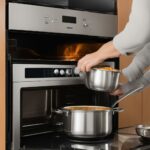 How to Reheat Soup and Keep It Delicious
How to Reheat Soup and Keep It Delicious
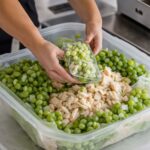 Can You Freeze Chicken Salad? Tips and Considerations
Can You Freeze Chicken Salad? Tips and Considerations
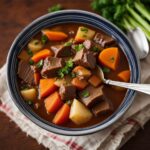 Beef Stew Shelf Life: How Long Does It Last in the Fridge?
Beef Stew Shelf Life: How Long Does It Last in the Fridge?
 How to Tell if Ground Beef is Bad: Safety First
How to Tell if Ground Beef is Bad: Safety First
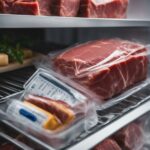 How to Store Meat for Freshness and Safety
How to Store Meat for Freshness and Safety




